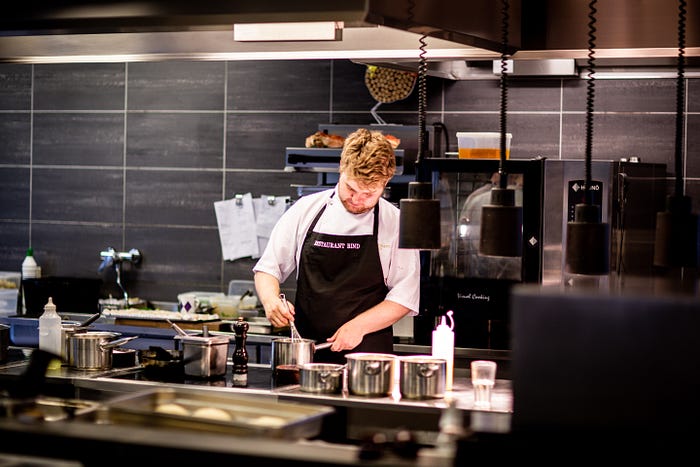Mastering the French Mother Sauces: Insights Beyond Recipes
Written on
Chapter 1: Discovering the French Mother Sauces
Throughout my recent culinary project focused on the five French Mother Sauces, I gained insights that transcended mere recipes. My journey into the world of sauces, originally conceptualized by August Escoffier, revealed much more than I anticipated. This experience allowed me to reconnect with my French Canadian roots and highlighted how cooking can serve as a tool for mental well-being.
Understanding that cooking is more about mastering techniques and ingredient combinations than following specific recipes was a significant revelation. The notion of five Mother Sauces may seem arbitrary, but their classification has evolved over time. For instance, in 1833, Carême identified four sauces, while Gouffé expanded this list to eleven in 1867. Escoffier's five sauces, established in 1903, represent a distilled essence of foundational culinary techniques.

The Essence of the Mother Sauces
Escoffier intended for the Mother Sauces to embody the simplest forms of base ingredients for sauces. For example, Béchamel sauce is created from flour and butter, combined into a roux and then blended with milk. Modifying Béchamel by adding cheese yields Mornay sauce, while incorporating puréed onions results in Soubise. This mother/daughter sauce model effectively illustrates the concept.
Conversely, Velouté is also derived from a roux of flour and butter, but it's dissolved in stock instead of milk. This leads to the realization that the roux is the common denominator between Béchamel and Velouté—both are variations of a thickening technique. While some may argue that a roux itself isn't a sauce, it's crucial to recognize that French cuisine heavily emphasizes technique.
If we categorize sauces by their preparation methods, we could argue there are three primary mother sauces: liaisons, réductions, and émulsions.
Section 1.1: Understanding Sauce Categories
Liaisons refer to sauces thickened using various agents like flour or egg yolks, with Béchamel and Velouté both falling into this category. Émulsions, on the other hand, combine ingredients that typically do not mix well, such as oil and water. A quintessential example is Hollandaise, which blends butter with lemon juice using egg yolk as an emulsifier. These mixtures can be tricky, often leading to separation.
Lastly, réductions involve evaporating water from stock to create a concentrated sauce. Although reduction steps exist in the preparation of mother sauces, they are not classified as reductions themselves.
Using Sauces in French Culinary Tradition
In North American cooking, one might equate chicken with Velouté sauce to chicken and gravy. However, the French approach to sauces is fundamentally different. In French cuisine, sauces are integral to the dish rather than mere condiments; they form the foundation of the meal. The preparation of Velouté is considered before deciding what to serve alongside it, similar to how one might approach wine pairings.
For those with limited wine options, the thought process shifts to determining what meal best complements the available bottle. In French cooking, sauces take precedence in meal planning, guiding the choice of dishes.
Chapter 2: The Influence of French Culinary Masters
The world of culinary arts boasts numerous renowned chefs, many of whom are either French or have been trained in French techniques. Among these culinary icons, Escoffier has gained legendary status, but I believe that Jacques Pépin will also be remembered alongside other greats such as Carême and Bocuse.
Pépin stands out not merely for his recipes or accolades but as a Master Teacher who has democratized cooking. He embodies the philosophy of "showing" rather than "telling," emphasizing the importance of practical demonstration over abstract instruction.
The first video, "Memorize all 5 Mother Sauces in 5 minutes," captures the essence of these foundational sauces and serves as a quick guide for aspiring chefs.
Pépin's book "La Technique" exemplifies this educational approach—it contains no recipes but is rich in visual guidance, illustrating the "how" behind culinary techniques. His dedication to making French cuisine accessible resonates through his interactions with culinary legends like Anthony Bourdain and Julia Child.
The second video, "Understanding The Five French Mother Sauces - A Brief Overview," provides a succinct introduction to the Mother Sauces and their applications in French cooking.
One of Pépin’s mantras has become my own: "You should always try the recipe at least once to understand what it is supposed to be. After that, you can start making changes until it becomes YOUR recipe."
Chapter 3: Personal Growth Through Culinary Challenges
Perhaps the most significant lesson from this cooking project is the value of self-challenge. While I currently find myself in a good place, I thrive on setting goals and pursuing new projects. There’s a distinct difference between having an adaptable plan and lacking one entirely; a flexible agenda provides necessary direction.
Looking ahead, I plan to explore new culinary horizons, perhaps by incorporating spicy oils into my repertoire. Join me on my journey of Cooking for Wellness as I continue to discover and grow through the art of cooking.